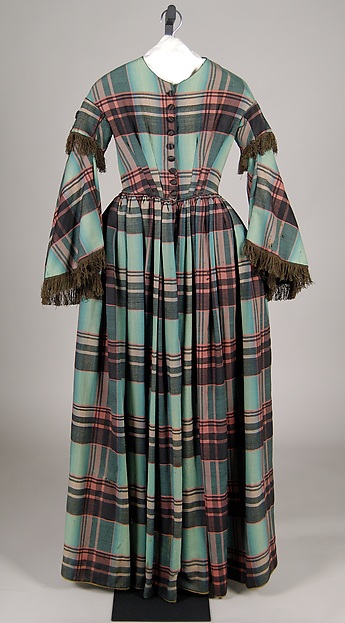I've been sitting on this one for a while--that is, I made up the skirt 2-3 years back, wore it with different contrasting basques and waists, finally made the bodice for last year's Christmas Regale, fit the sleeves badly so they tore out during use, and now have it in approximately working order. Ish.
The inspiration piece is this plaid wool from The Met, dated to the latter half of the fifties. I'm mostly in 1855 at the fort (with forays into 1857/1859), so it's a good fit.
 |
| Wool dress, c. 1855-1860, from The Met |
The original dress has open sleeves which appear to be pagodas (they could be funnels, but seem to curve at the seam as pagodas do); both the wrist edge and the sleeve caps are edged in fringe, a popular trim choice for the mid-to-late 1850s. The bodice is fitted with three darts on each side of the center front opening, which fastens with functional buttons (button holes are visible on the left side of the three lowest buttons). Self-fabric piping finishes the bodice at the armscye, waist, and possibly at the neckline, though the latter may simply be bound. There is no waistband. The skirt is finished with hem tape, which appears to be tacked on the wrong side of the hem, or sandwiched between the skirt and facing (it is not folded over the hem edge). The skirt is gauged at the waist--uncommon for wools by the 1860s, but not unknown in the 1850s.
So far as I can tell, the sleeve cap takes up about 1/4 of the total sleeve length (at the inner seam), and 1/5 at the outer; adapting for my sleeve length, that's about a 4"-4.5" long jockey, and suggests that the fringe is about 2.5" long. My version has shorter fringe due to fears about tangling it (and the time took to make). I do like the look of the deeper fringe, though...
 |
The dress form is stuck on its lowest setting,
so nothing really sits right on it. |


No comments:
Post a Comment
Thanks for commenting!